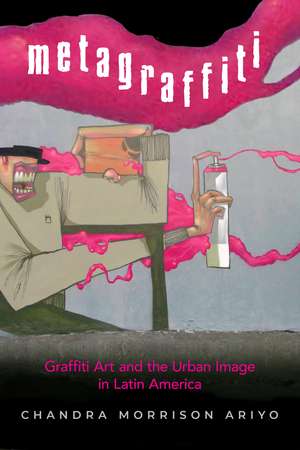Metagraffiti: Graffiti Art and the Urban Image in Latin America
Autor Chandra Morrison Ariyoen Limba Engleză Paperback – 13 dec 2024
Preț: 229.85 lei
Nou
Puncte Express: 345
Preț estimativ în valută:
43.98€ • 46.01$ • 36.54£
43.98€ • 46.01$ • 36.54£
Carte disponibilă
Livrare economică 13-27 martie
Livrare express 26 februarie-04 martie pentru 23.97 lei
Preluare comenzi: 021 569.72.76
Specificații
ISBN-13: 9781978834408
ISBN-10: 1978834403
Pagini: 224
Ilustrații: 25 color and 10 B-W images
Dimensiuni: 156 x 235 x 18 mm
Greutate: 0.32 kg
Editura: Rutgers University Press
Colecția Rutgers University Press
ISBN-10: 1978834403
Pagini: 224
Ilustrații: 25 color and 10 B-W images
Dimensiuni: 156 x 235 x 18 mm
Greutate: 0.32 kg
Editura: Rutgers University Press
Colecția Rutgers University Press
Notă biografică
CHANDRA MORRISON ARIYO is a visiting research fellow in the Department of Geography and Environment at the London School of Economics and Political Science.
Cuprins
Chapter 1: Metagraffiti: Envisioning a Concept
Chapter 2: Urban Image: Painting (in) the Latin American City
Chapter 3: Signature Wordplay: Self-Naming, Misspelling, and Rewriting the Social Order
Chapter 4: Figurative Threat: Stigma Embodiment and Graffiti's Violent Characterization
Chapter 5: Reflective Structures: On Murals and Mirroring in the Spatial Imagination
Chapter 6: Painting Pollution: Cleaning the City and Recycling Social Values with Street Art
Chapter 7: Graffiti Intimacies: Seeing the City in Color
1 METAGRAFFITI
Envisioning a Concept 1
2 URBAN IMAGE
Painting (in) the Latin American City 23
3 SIGNATURE WORDPLAY
Self-naming, Mis-spelling, and Re-writing the Social Order 67
4 F FIGURATIVE THREAT
Stigma Embodiment and Graffiti’s Violent Characterization 93
5 REFLECTIVE STRUCTURES
On Murals and Mirroring in the Spatial Imagination 125
6 PAINTING POLLUTION
Cleaning the City and Recycling Social Values with Street Art 153
7 GRAFFITI INTIMACIES
Seeing the City in Color 175
Acknowledgments 183
Notes 187
References 191
Index 000
Chapter 2: Urban Image: Painting (in) the Latin American City
Chapter 3: Signature Wordplay: Self-Naming, Misspelling, and Rewriting the Social Order
Chapter 4: Figurative Threat: Stigma Embodiment and Graffiti's Violent Characterization
Chapter 5: Reflective Structures: On Murals and Mirroring in the Spatial Imagination
Chapter 6: Painting Pollution: Cleaning the City and Recycling Social Values with Street Art
Chapter 7: Graffiti Intimacies: Seeing the City in Color
1 METAGRAFFITI
Envisioning a Concept 1
2 URBAN IMAGE
Painting (in) the Latin American City 23
3 SIGNATURE WORDPLAY
Self-naming, Mis-spelling, and Re-writing the Social Order 67
4 F FIGURATIVE THREAT
Stigma Embodiment and Graffiti’s Violent Characterization 93
5 REFLECTIVE STRUCTURES
On Murals and Mirroring in the Spatial Imagination 125
6 PAINTING POLLUTION
Cleaning the City and Recycling Social Values with Street Art 153
7 GRAFFITI INTIMACIES
Seeing the City in Color 175
Acknowledgments 183
Notes 187
References 191
Index 000
Recenzii
"Metagraffiti is beautifully written, conceptually powerful, and empirically nuanced, offering the idea of 'metagraffiti' as a frame to understand the many discourses about graffiti’s multiple functions, representations, and ongoing evolution in Latin America and the world. This book is an excellent resource for research and teaching around graffiti, the urban image, and forms of voicing. The specificity with which Morrison Ariyo attends to the form, process, and function of graffiti is impressive and will energize future scholarship. I highly recommend this text."
"Chandra Morrison Ariyo's analysis of Latin American graffiti examines the way in which metagraffiti—what she innovatively conceives of as a graffiti about graffiti, a graffiti about graffiti as image, practice, and culture—creates both internal cohesion as much as an external awareness of the implications and potentialities of this image world in itself. Innovative and ethnographically rich, Metagraffiti is a critical contribution to the field."
"Chandra Morrison Ariyo's analysis of Latin American graffiti examines the way in which metagraffiti—what she innovatively conceives of as a graffiti about graffiti, a graffiti about graffiti as image, practice, and culture—creates both internal cohesion as much as an external awareness of the implications and potentialities of this image world in itself. Innovative and ethnographically rich, Metagraffiti is a critical contribution to the field."
Descriere
This innovative visual ethnography examines diverse forms of self-reference and metareference that appear in Latin American graffiti art. Focusing on graffiti scenes from São Paulo, Brazil and Santiago in Chile, Chandra Morrison Ariyo shows how practitioners use metagraffiti features to influence public perceptions about this artform and its effect on the urban environment.
